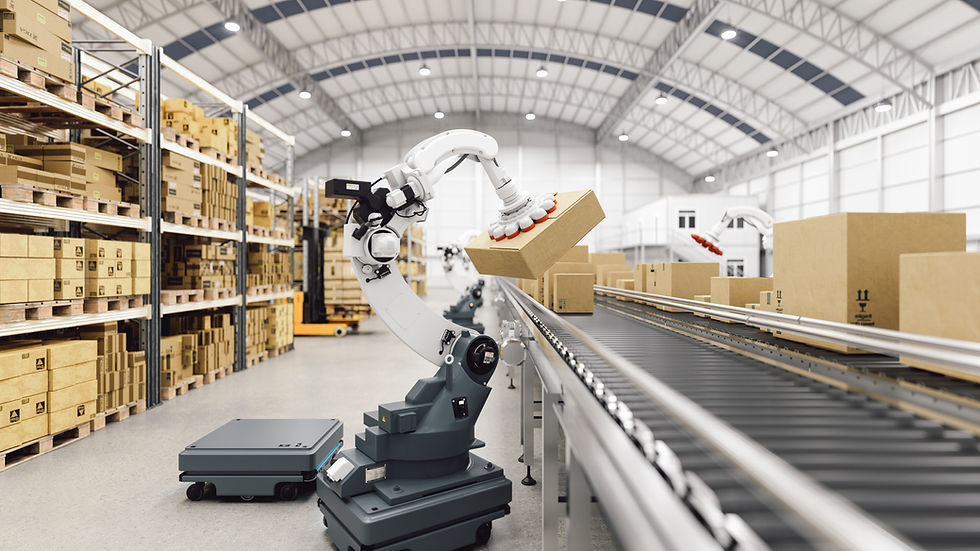Robotics and Automation: Transforming Industries and the Workforce
- Shreya Giri
- Jul 22, 2023
- 5 min read
The world is witnessing a profound transformation in various industries, thanks to the rapid advancements in robotics and automation. With the integration of intelligent machines, these technologies are revolutionizing the way we work and reshaping industries across the globe.
From manufacturing and healthcare to agriculture and logistics, robotics and automation are streamlining processes, enhancing productivity, and ultimately transforming the workforce. In this article, we will explore the significant impact of robotics and automation on industries and the workforce.

Enhanced efficiency and productivity
One of the primary advantages of robotics and automation lies in their ability to improve efficiency and productivity. Robots excel at performing repetitive and mundane tasks with precision and speed, surpassing human capabilities.
By automating these tasks, human workers are liberated to focus on more complex and creative endeavors. This augmentation of the workforce leads to increased productivity, as both humans and machines work collaboratively to achieve optimal results.
Automated systems also offer the advantage of continuous operation. Unlike human workers, robots can operate 24/7, reducing downtime and maximizing output. This not only enhances productivity but also contributes to significant cost savings.
Moreover, the accuracy and consistency provided by robotics and automation reduce the likelihood of errors, resulting in higher-quality products and services.
Safety and Risk Mitigation
Creating a safe work environment is a top priority for industries, and robotics and automation play a crucial role in achieving this objective. By delegating hazardous or physically demanding tasks to robots, the risk of accidents and injuries to human workers is significantly reduced.
Robots are well-suited to work in extreme conditions, such as high temperatures, toxic environments, or confined spaces, where human presence can be perilous.
In industries like manufacturing, robots can handle heavy lifting or operate heavy machinery with precision, minimizing the strain on human workers. They can also be deployed in dangerous environments like nuclear facilities or disaster zones, carrying out critical tasks while ensuring human safety.

Precision and Quality Control
Quality control is a vital aspect of industries, and robotics and automation have revolutionized this process. With their unmatched precision and consistency, robots eliminate variations caused by human factors, leading to improved product quality.
In manufacturing, automated systems can conduct thorough inspections, identifying even the minutest defects that may go unnoticed by human eyes. This ensures that products meet stringent quality standards, increasing customer satisfaction and enhancing brand reputation.
Moreover, robots are capable of executing tasks with a high degree of accuracy, reducing errors and waste. This precision is particularly valuable in industries such as pharmaceuticals, electronics, and automotive, where minor deviations can have significant consequences.
By integrating robotics and automation into quality control processes, industries can achieve greater reliability and consistency in their products and services.
Workforce Augmentation and Collaboration
Contrary to the fear that robotics and automation will lead to massive job losses, these technologies are actually transforming the workforce rather than replacing it. The introduction of robots allows human workers to shift their focus from repetitive and monotonous tasks to more complex and creative endeavors.
This augmentation of the workforce fosters a collaborative work environment, where humans and machines work together to achieve common goals. By delegating routine tasks to robots, employees have the opportunity to engage in problem-solving, innovation, and customer interaction.
This not only enhances job satisfaction but also empowers workers to contribute to higher-value activities that require human ingenuity and empathy. The collaboration between humans and machines leads to enhanced productivity and improved overall performance within organizations.

Upskilling and Reskilling Opportunities
As automation continues to reshape industries, it also presents an opportunity for the workforce to up-skill and reskill. With the adoption of robotics and automation, new job roles and opportunities emerge, demanding a different skill set. Organizations and educational institutions must focus on providing training programs and resources to equip workers with the necessary expertise to thrive in this evolving landscape.
Up-skilling involves acquiring new skills that align with the technological advancements brought about by robotics and automation. This may include learning programming languages, understanding AI algorithms, or acquiring knowledge in areas like machine learning and data analysis.
Reskilling, on the other hand, involves transitioning workers from occupations that may be at risk of automation into new roles that complement these technologies. This can involve developing skills in areas such as human-machine interaction, robot maintenance, or data management.
By embracing lifelong learning and adapting to technological changes, individuals can secure their employability in the evolving job market. Governments, organizations, and educational institutions should collaborate to provide comprehensive training programs, incentivize upskilling and reskilling initiatives, and create a supportive environment for workers to embrace the opportunities presented by robotics and automation.
Economic Implications
The widespread implementation of robotics and automation has significant economic implications. While there may be short-term disruptions as industries undergo transitions, the long-term benefits are substantial. Increased productivity, improved quality, and reduced costs contribute to economic growth and competitiveness.
With enhanced efficiency, businesses can produce goods and services more effectively, leading to higher outputs and increased revenue. The cost savings achieved through automation can be reinvested in research and development, innovation, and expansion. This, in turn, drives economic growth, creating new job opportunities in emerging sectors related to robotics, AI, and advanced technologies. Furthermore, as industries evolve, new opportunities for entrepreneurship and innovation arise.
The development of robotics and automation technologies has spawned a new ecosystem of startups and businesses that cater to the growing demand in these fields. This entrepreneurial activity fosters job creation and drives economic dynamism, transforming industries and opening up avenues for future growth.

Conclusion
Robotics and automation are reshaping industries and transforming the workforce, revolutionizing the way we work and operate. From enhanced efficiency and productivity to improved safety and quality control, the benefits of these technologies are extensive.
Rather than replacing human workers, robotics and automation augment the workforce, empowering employees to focus on higher-value tasks and fostering collaboration between humans and machines.
To fully harness the potential of robotics and automation, it is crucial for industries, governments, and individuals to adapt, upskill, and embrace the opportunities that arise in this new era of technology-driven transformation.
By investing in training programs, supporting research and development, and fostering an environment that encourages innovation and creativity, we can ensure a prosperous future where humans and machines work hand in hand to drive progress and economic growth.
About the Author
Shreya Giri is a talented SEO content writer with a unique flair for captivating readers. With a bachelor's degree in geography, her passion for crafting exceptional content shines through in every word she writes. Shreya's expertise lies in her ability to seamlessly blend language and storytelling, effortlessly capturing the attention of her audience.
She is currently pursuing a Master's degree in geography and has a remarkable talent for transforming intricate concepts into captivating narratives that have a lasting impact. With Shreya, you can expect excellent, captivating content that will keep you engaged from beginning to end.
You can connect with her through-
My-Lekh profile- lekh.com/profile/shreyagiri06/profile LinkedIn profile- https://www.linkedin.com/in/shreya-giri-a0a607265
Email- shreyagiri06@gmail.com





Comments